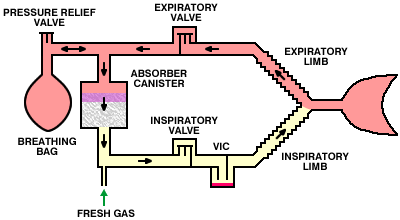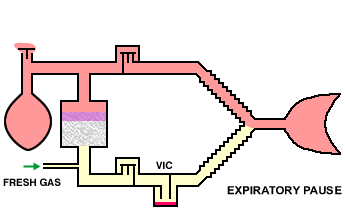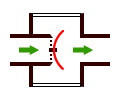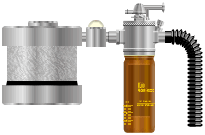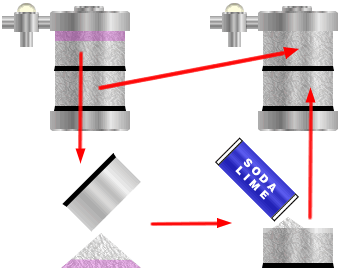 |
||||||||||||||||||
|
|
|
Circle Absorber Construction
The essential
features of the circle absorber are: a carbon dioxide absorber canister
(C), breathing bag (B), unidirectional inspiratory (Vi) and expiratory
(Ve) valves, fresh gas supply (F) and pressure-relief valve (V).
The absorber is connected to the patient via corrugated hoses and
a Y-piece (not shown) attached to the inspiratory and expiratory
valves (Vi and Ve). Function
Inspiration:
Inspiration causes the expiratory valve to close and gas flows from
the breathing bag to the patient via the inspiratory limb of the
circuit. Anesthetic is taken up from the in-circuit vaporizer (VIC),
if fitted. Closed and semi-closed The circle absorber may be used as a closed or semi-closed system:
Canister gas flow Most modern
canisters are orientated vertically, which facilitates changing
the absorbant and avoids the problems of channelling encountered
with horizontal canisters (as described under the Waters'
Canister). In most absorbers, gas flows from the top to the
bottom of the canister, although in some gas flows from the bottom
to the top.
Furthermore, in bottom-to-top flow absorbers, condensed water vapor tends to accumulate at the bottom of the canister and may cause the absorbant to become water-logged. In top-to-bottom flow absorbers, gravity leads to more even distribution of condensed water vapor throughout the absorbant. Unidirectional valves The unidirectional inspiratory and expiratory valves in most circle absorbers are of the turret type, in which the pressure generated by the patient's breathing causes the disc to rise and allow gas to pass in one direction only. Most have a transparent dome so that the operation of the valve may be observed.
The disc material may be mica, ceramic or plastic. Plastic is less expensive, but tends to warp and allow the valve to become incompetent. Incompetence may also be caused by the valve sticking in the open position owing to condensation of water vapor. Incompetent inspiratory or expiratory valves will reduce the efficiency of gas circulation and result in rebreathing and consequent carbon dioxide retention. Some machines are equipped with valves made of deformable rubber:
As the rubber ages, these discs tend to harden in a semi-open position, again allowing the valve to become incompetent. Connecting tubing The body of the absorber is connected to the patient by means of inspiratory and expiratory tubes and a Y-piece. This may be constructed of corrugated black rubber, neoprene or, more recently, plastic.
Recently, the so-called Universal F circuit has become popular. This is a co-axial system, the inspiratory tube running inside the expiratory limb:
This arrangement aids warming and humidification of the inspired gases, albeit at the expense of an increase in inspiratory resistance to breathing. One problem with this system, as with other co-axial circuits, is that, if the inner tube breaks or becomes disconnected at the absorber end (which may not be noticed on casual inspection), the entire volume of the tube becomes apparatus dead space. It should also be noted that, in all other aspects, this system is identical in function to a conventional, dual-limb system, and does not provide an economical alternative to the Bain system (although it is occasionally marketed as doing so). Patient Size Most circle
absorbers constructed for use in human-sized animals are satisfactory
for use in patients weighing up to around 100 kg. For larger animals
(e.g. horses and cattle), purpose-built large animal absorbers should
be used. These have larger absorber canisters and larger tubing
and valves in order to reduce resistance to breathing.
These difficulties may be reduced by the use of purpose-built infant absorbers, which are smaller than the standard models. Pediatric tubing and Y-pieces, which are simply smaller in diameter than the standard type, may be helpful. Purpose-built fans may also be used to circulate the gases, but these are not comonly encountered in veterinary practice. In- and out-of-circuit vaporizers An inhalation anesthetic agent may be supplied from a vaporizer positioned in the circle itself (vaporizer in circuit, VIC) or in the fresh gas flow from the anesthetic machine (vaporizer out of circuit, VOC).
Although low-resistance vaporizers are usually relatively inefficient (with the output of, for example, halothane limited to around 2.5 to 3%), the concentration of anesthetic inspired by the patient may be very much higher than this because the gas entering the vaporizer also contains anesthetic from previous circulations. Indeed, after full equilibration of the circuit and patient, the inspired concentration would equal the SVP of the anesthetic, although obviously the patient would have expired long before this point was reached. It is therefore strongly recommended that an inhalation anesthetic analyzer be used to monitor the inspired concentration whenever such systems are used. In-circuit vaporizers can be used with closed or semi-closed systems. Since water vapor exhaled by the patient condenses in the vaporizer, it is necessary to drain in-circuit vaporizers regularly.
Double-canister absorbers Many absorbers designed for use in human patients employ two canisters placed in series: the top canister is exposed to the expired gases first and removes most of the carbon dioxide. Any remaining carbon dioxide is then removed by the bottom canister. When the top canister is exhausted, the absorbent is discarded, the bottom canister is placed in the top position and a canister with fresh absorbent is inserted underneath it. This arrangement provides optimal efficiency and economy in carbon dioxide absorption. However, these absorbers are bulkier, heavier and more expensive than single-canister models.
Operational requirements
Advantages of the circle system
Disadvantages
Uses
|
Comments on this
article should be addressed to Dr Guy
Watney
All pages © Anesthesia Service
and Equipment 1998-2003.

